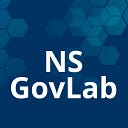NS GOVLAB HARNESSES POWER OF SOCIAL INNOVATION LABS TO MEET CHALLENGES OF DEMOGRAPHIC SHIFTS
note: this blog was originally posted by Gevity Consulting Inc. The original post can be found here: https://www.gevityinc.com/channel-gevity/gevity-health-care-blog/ns-govlab-harnesses-power-social-innovation-labs-meet
Bronwyn Zuck, Gevity Management Consultant and Nova Scotian, was intrigued when she heard about an opportunity to join NS GovLab, a social innovation project managed by the Government of Nova Scotia to address issues presented by an aging population.
Nova Scotia’s social innovation lab is a participatory, immersive research program in which select volunteers spend six months learning the foundational principles and approaches of the program, followed by six months of collaborative practice in which participants work on specific problems related to aging in place and to building stronger communities.
Aubrie McGibbon, Data and Evaluation Lead for NS GovLab, explains that social innovation labs use systems and design theory as well as human-centred design methods to understand issues, develop appropriate responses, test ideas, and learn from their initiatives.
“There are many examples of social innovation labs focused on different policy issues across Canada, but NS GovLab focuses on aging populations in Nova Scotia,” Aubrie says. “Examples of issues NS GovLab has addressed include food security and local food availability, and transportation in rural areas. Interest in the initiative has been strong; there were more than 80 applicants for 25 spots for the first cohort alone.”
Aubrie notes that Nova Scotia is motivated by current demographic trends, but also sees the opportunity to take a creative approach to social issues. “Nova Scotia is currently tied with New Brunswick and Florida as the oldest populations in North America,” Aubrie explains. “About one in five people in Nova Scotia are over 65; by 2030, that ratio is expected to increase to one in four. To prepare for the changes and opportunities that these demographic changes are expected to bring, the provincial government has adopted the Shift Action Plan for an Aging Population, which aims to help seniors stay healthy and active, enable them to remain in their homes for as long as possible, and value their continuing contributions to the community.”
In May 2019, Bronwyn responded to the NS GovLab’s call for volunteers in its third cohort and was pleased to be accepted for a one-year fellowship.
“I had recently moved back to Nova Scotia and the Lab piqued my interest for a few reasons,” she says. “I am interested in Canada’s aging population and the challenges this demographic shift presents. NS GovLab offered an opportunity to explore these complex challenges through a lens of social innovation, and to connect with and learn from other Nova Scotians sharing similar concerns. Based on previous project experience, I was convinced that a design thinking approach would be productive and appropriate and was eager to become involved.”
Since starting, Bronwyn has worked with a team researching the relationship between social connectedness and positive aging. They are developing ideas about maintaining and promoting informal social connections and support systems that include older adults in Nova Scotia and are prototyping program responses.
“It’s a different approach to problems,” she says. “The focus on those at the point of impact (in this case, older adults) affords a unique depth of insight, and the project team includes older adults and people from public and private program delivery agencies. This aligns with my experience with healthcare IT, which leads me to believe that success must be measured by patients’ and clinicians’ experience. IT systems are most successful when the focus is on the users and when systems are designed with their help and are responsive to their needs.”
